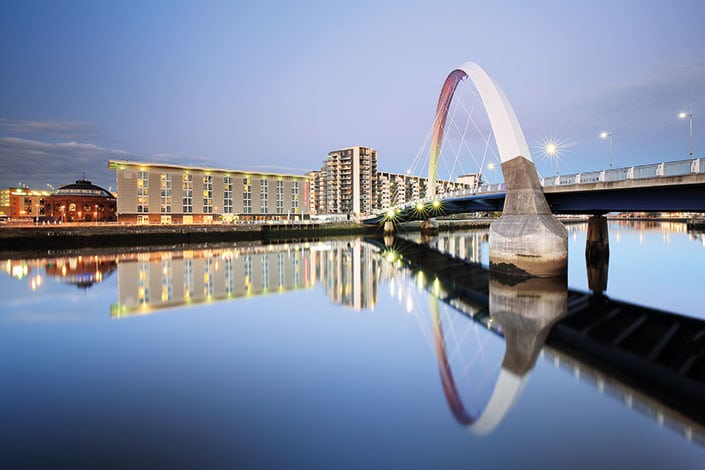Glasgow: An Investor’s Dream
Share

Glasgow, formerly known as the “Second City of the Empire” thanks to its Victorian shipbuilding credentials, is reliving its heyday, but this time things are different, for the success it currently enjoys is built on much stronger foundations. Thanks to a dedicated strategy to make Glasgow the most productive UK major city economy, and initiatives such as the Clyde Waterfront programme which has seen massive regeneration all the way along the River Clyde, Glasgow has undergone a dramatic transformation in recent years, with the result that it now boasts a transport and IT infrastructure befitting the world class city that it is.
Whether travelling by road, rail or air, recent major improvement works have relieved congestion and enhanced capacity, while this super-connectivity is echoed in the IT realm, thanks to £50 million of investment in future-proof broadband infrastructure. This digital connectivity even extends to the city’s underground system with the provision of a combined cellular and wifi network, while the “Digital Glasgow” initiative aims to achieve comprehensive digital coverage, and introduce world-class broadband in key areas of development, as well as further encompassing a digital business incubation and start up programme, amongst much else besides.
“Life sciences has flourished so readily in the region, thanks to specific measures put in place to attract and support investment.”
In focusing its energies on developing its strengths and reputation in select fields, Glasgow has successfully carved out for itself a deserved reputation as a global leader in sectors such as financial services, the creative industries, low carbon, and life sciences, to name but a few, which has helped it to remain remarkably resilient to the effects of the global financial crisis, which has ravaged many a city’s economy. This specialised focus has resulted in rapid growth for the flagship industries in question, with investors attracted by competitive costs and impressive human capital, the value of which is second to none. What’s more, beyond “Digital Glasgow”, initiatives such as “Sustainable Glasgow”, the “International Financial Services District” (IFSD) and “City Science” provide further indication as to where the city sees its future lying.

Glasgow’s development landscape is vibrant to say the least, as the city looks to continue its revitalisation in fully sustainable fashion. Headline developments include Pacific Quay Digital Media Quarter, which feature’s Europe’s most advanced broadcasting facilities; the aforementioned IFSD initiative, the result of £1 billion of public/private investment, which has brought more than 15,000 financial and business services jobs to the city since its inception; the SECC Precinct project to renovate and transform the Scottish Exhibition and Conference Centre into a multi-purpose complex; the Clyde Gateway Urban Regeneration Company, which aims to reinvigorate premium land to the east of the city centre; Glasgow Harbour, where there are plans to create a striking mixed-use development; as well as the City Science and International Technology and Renewable Energy Zone (ITREZ), a business quarter set to specialise in science and technology.
Life Sciences
With over £8 billion having been invested over the last five years, right now Glasgow constitutes not only the premium FDI destination within Scotland, but is also now internationally significant in this regard. The life sciences sector, in particular, has recorded explosive growth, such that it now rivals the likes of Boston, Mass; Ontario, Canada and the Swiss/German/French BioValley region, its ongoing development in Glasgow informed by the city’s embracing of open innovation. Projects of particular renown include the University of Strathclyde’s Technology and Innovation Centre, three speculative Grade A office developments and the Queen Elizabeth University Hospital. Life sciences has flourished so readily in the region, thanks to specific measures put in place to attract and support investment.
Central to these is the Glasgow and Clyde Valley City Deal, which is set to see over a billion pounds invested into the local economy over the next 20 years, in the process creating tens of thousands of jobs and catalysing over £3bn of investment. In addition, administrative developments within the Glasgow public sector have acted to streamline and enhance the investment process.
This equates to customised and comprehensive support in respect of recruitment, premises, market intelligence and planning, as well as accessing grants, loans and funding, on top of committed aftercare to ensure all those that come, prosper. It is an approach which has collaboration at its heart to ensure all pertinent public bodies are singing from the same hymn sheet in addressing the needs of investors both incumbent and prospective, such that access is afforded to all of Scottish Enterprise, Scottish Development International, Glasgow Chamber of Commerce, property agents and other Council services such as Planning and Business Services.
Of special interest to would-be investors will be the additional funding for an Imaging Centre of Excellence within the Stratified Medicine Scotland Innovation Centre located at the new South Glasgow Hospital campus, as well as support for the development of a MediCity Scotland facility and a new Centre for Business Incubation and Development, that will support services for high-growth companies in the enabling technology, advanced design and manufacturing, and creative economy sectors.

It would be no exaggeration to say that the Glasgow BioCorridor is now home to one of the largest life sciences clusters in Europe, exhibiting noteworthy prowess across the medical technology, clinical and translational medicine, pharmaceutical services and regenerative medicine disciplines. With each new addition to the cluster, the job of attracting further life science FDI projects to the region becomes that much easier, for the strength in depth and economies of scale are strongly apparent, while the presence of multinationals, such as GlaxoSmithkline only serves to add to the appeal.
The facts speak for themselves: Some 29 life sciences companies and counting operate out of Glasgow, while the city and the wider West of Scotland region’s universities produce almost 6000 first degree life science graduates per year, constituting a rich reservoir of emerging and enthusiastic talent from which investors can draw. Meanwhile, Scotland, taken as a whole, is the European leader when it comes to medical research conducted per capita.
In addition, the knock-on effects of Glasgow’s burgeoning life sciences sector are profound and positive with a significant array of complementary professional services such as law firms, patent agents and business consultants having come into existence directly off the back of its growth. Furthermore, investors are attracted by the successful marriage of industry, academia and the public sector, as well as overheads which pale into insignificance next to the likes of other life sciences centres in the UK, most notably London and Cambridge, where equivalent costs are, respectively, 75% and 11% higher than in Glasgow. In addition, with world class facilities, such as the newly-created Industrial Biotechnology Innovation Centre at the University of Strathclyde, and the Strathclyde Institute of Medical Devices, for many investors determining where to start-up, expand or relocate, the decision is a straightforward one.


























